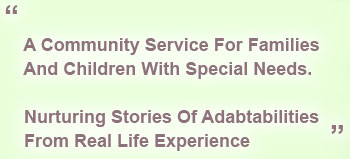PART IV: INTRODUCTION
Narrative Tools for Building Adaptive Identities
| Part IV Documents |
Forms & Handouts (Cont.)
|
||
| Part IV Forms & Handouts (PDF) | |||
After heart, mind and body, we seek to include the spirit of person’s lived experience from the meanings, values and purposes we gain from life’s experiences—disabilities and all. Here, we ask, “Why?”, “What is the significance?”, “What difference does this problem/solution make for you now?” and “How do you make sense of what happened?” We believe a child and family’s relating to their own experience of significance is generative and restorative and that this is the place from which new beliefs about one’s sense of self may be appreciated and esteemed. Where the child and family arrive at their own motivating and influencing statements, we have the narrative grist—our “holy grail”—from which a description of themselves, threads through personal stories of hardship, of questing and of recovery or improvement. A client’s expression of these ideas may not need to be verbal or written, but may include multiple forms of movement, dance, sports, art, music and other non-verbal ways to communicate, which have character-forming properties, new beliefs which compel and inform a client’s resilient internal flow.
We have formulated several hierarchical categories originating from the child, family, school and the cultural community bringing multiple sources of healing resources beginning with the formation of safety and protective boundaries, feeling a sense of belonging, and finding a voice by having it acknowledged and validated. Further we offer these enriched anecdotal experiences to test out one’s reflective and relational capacities, increased sense of understanding, which hopefully leads to a clearer definition of one’s multiple identities. This particular dynamic fosters an altered perspective of who we are and how we fit in relation to the deficits, disabilities and misfortunes we encounter.
| [Back to Top] |








Social Networks
Follow Us